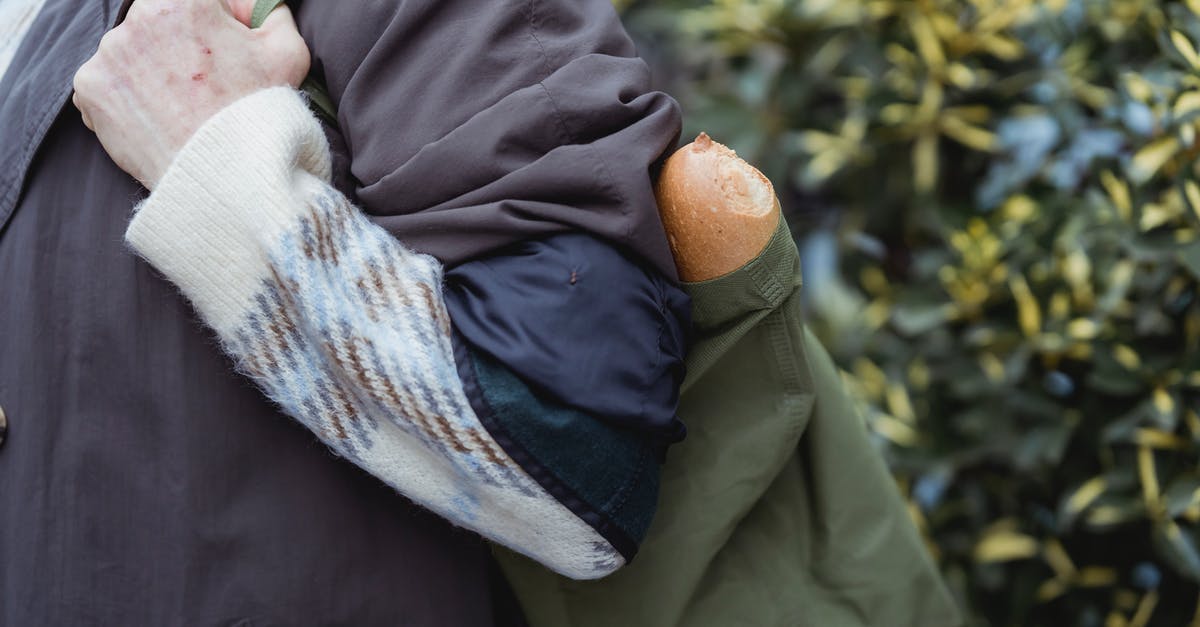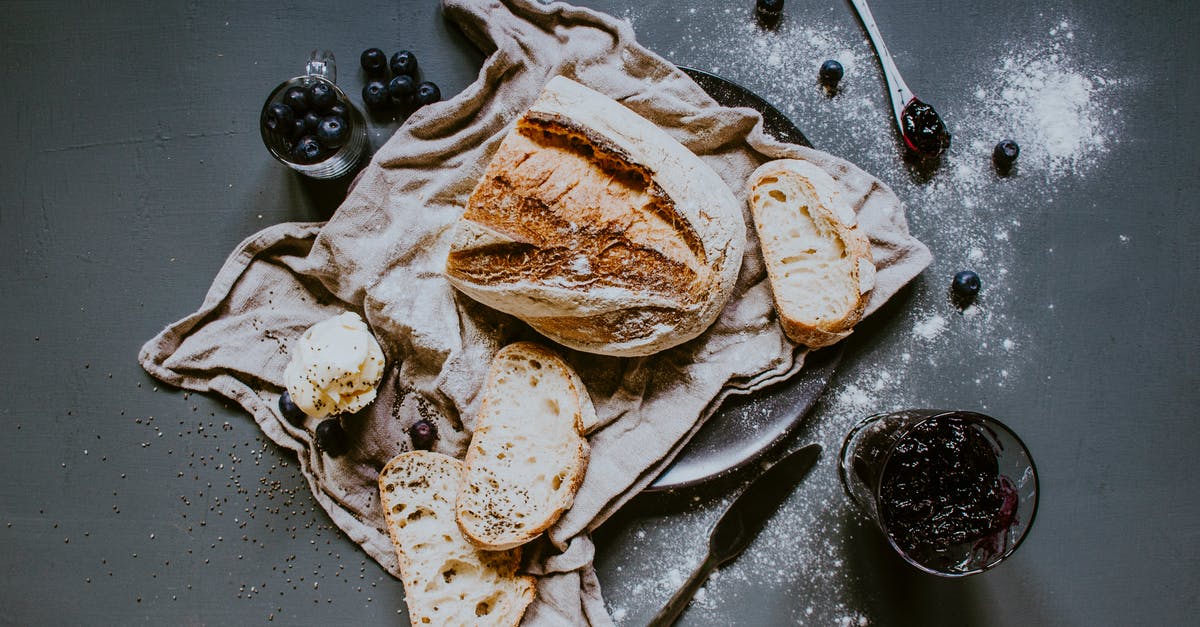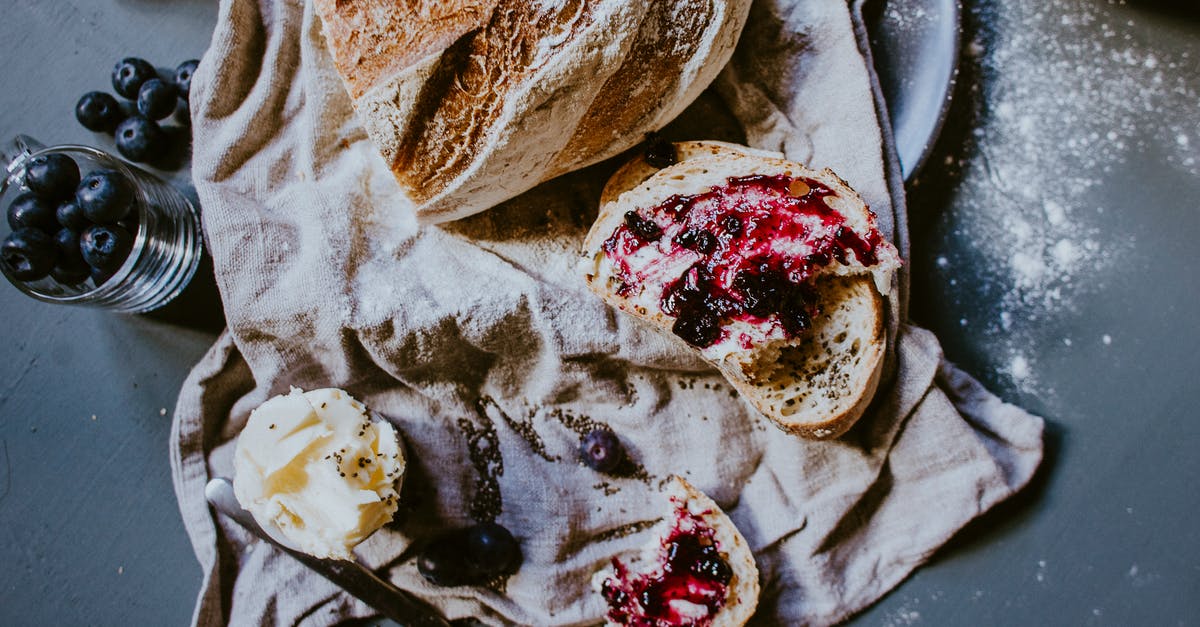Bread has tough, crunchy crust but is underbaked in the middle - how to fix?

I've been attempting to make white bread using a recipe from my grandmother. However, since she used to bake this bread every weekend and could probably have done it in her sleep, when she wrote down the recipe she was very vague. Recipe is as follows:
In a large bowl:
4 cups boiling water
3-4 tablespoons shortening
6 tablespoons sugar
1 tablespoon salt (this may be left out)In a medium bowl:
2 cups cold water
2 cups hot water
1 1/2 cups powdered milkIn a small bowl:
3 tablespoons yeast
2 teaspoons sugar
1 cup water 110-115 degreesLet yeast dissolve and begin action. Mix all ingredients in large bowl, making sure hot liquids have cooled enough before adding dissolved yeast. Add flour (not too much) and beat with electric beater for a few minutes. Add enough flour to make a firm dough. Knead approximately 8 minutes. Grease large bowl and place dough in bowl. Grease top of dough. Let rise. Punch down and shape into loaves. Grease pans and place loaves in pan and grease top of loaves. Let rise. Bake at 350 degrees approximately 30-40 minutes.
I usually halve the recipe since it results in a lot of bread otherwise. When halved, I add roughly 8-9 cups of flour (I have a flour scoop that picks up just over 1 cup flour) into the dough before rising, then another 2-3 cups that get mixed in while I'm trying to knead and using flour to keep the dough from sticking to everything.
One of the problems I'm having is crust vs interior doneness. Every attempt so far has resulted in a very thick crust which is either painfully chewy, extremely dry and crispy, or both; while the inside of the loaf is doughy and undercooked.
My grandmother's oven was 40-50 years old, beneath a gas stove, and not in the best of shape, so I wouldn't be surprised if it wasn't actually baking at 350 degrees. Also, she lived in Michigan while I live in the Pacific Northwest (basically at sea level), so that's probably also not helping things.
What should I do differently to get bread that's fully baked in the middle, without a crust that's difficult to chew?
Best Answer
First off, there is a way bakers measure the proportions of ingredients that is pretty unique to bread—everything is measured relative to the amount of flour by weight. A ratio of 0.6 (or 60%) means if you use 10oz of flour, you use 6oz of that other ingredient.
There are typical ranges for these. For example, salt will typically be 1–2%, yeast (depending on type of yeast) ?2%. Water will be between 55–85% (the low end is bagels, the high end is various artisan rustic breads), and typically 60–66%. Note that high gluten flours (like bread flour) soak up more water than lower gluten flours (like all-purpose), so they'll need a few % more water. The more water the looser and tackier a dough becomes (and, ultimately, becomes a batter instead with enough water.)
Please forgive me for working the rest of this in metric, it's what I normally use to bake. Yes, despite being American… The math is so much easier without having to do lb?oz, etc. conversions.
Your recipe has 9 cups of water, which is ?2130g. It calls for a firm dough, and you're using bread flour, and hand kneading (which means you'll add a little more in from dusting as you knead) so I'd go with around 62%. That'd be 3435g of flour (2130÷0.62). [That's 121 oz, or 24 c. if you insist.] We can now use that to compute the baker's ratios of the other ingredients:
- 3T of yeast, according to an online converter is ?29g. So that's 0.85%, which is reasonable.
- 3–4T shortening is ?1–1.5%. Shortening (or fat in general) tends to make bread less chewy (think of a good baguette and how that has a chewy toughness to it—shortening lessens that.)
- 1½ c. powdered milk is about 100g, about 3%.
- 6T + 2t sugar is about 85g, or 2.5%.
- 1T table salt is 17g (0.5%). There is another gram or so in the powdered milk. Salt slows down yeast, and does various other things, but mainly it's for flavor.
Those all look pretty reasonable, so this recipe should work. (Personally, I'd suggest doubling the amount of salt in there, for flavor.) Also, it's possible that all-purpose flour might actually work better than bread flour, since you're not going for chewy.
Now, for some ways it can go wrong:
- You're putting a lot of warm ingredients in your dough. Starting with boiling water (I have no idea why, honestly. Maybe to melt the shortening?). Then you add hot water, and finally some cold water. Unless "cold water" means "ice", the resulting mix is still going to be hot. You must not heat the yeast above 130°F. That will kill them pretty quickly. I'd interpret that "cooled enough" step to mean 115°F at most.
- If you measure your flour by volume (cups), that's error-prone (you can easily put anywhere from 4–6oz/cup, depending on how you measure). A $20 digital scale is far superior and quicker, too.
- When you start kneading this, it's going to be tacky and stick, at least once you get all the flour mixed in. Try not to add too much additional flour while kneading—use only the minimum required to make it handleable. As you knead, even without adding flour, it will get better. You can use a bench scraper (or a pie server or even a table knife in a pinch) to help pull it off the board if it sticks.
- If at some point during kneading it becomes stretchy and difficult, let it rest for a few minutes.
- This dough should double (and no more) before you knock it down. Then you shape it (and there is a technique to that), and it should double again in the loaf pans. Be patient.
- When done baking, the center should be at least 190°F, maybe even 200°F. If it's under 190°F, put it back in the oven. Feel free to turn down the oven if its browning too much. (Though I think your times are reasonable.)
Finally, almost all bread has a crispy crust after cooling fresh out of the oven. Once it cools, place it in a plastic bag for a few hours—that'll soften the crust.
Pictures about "Bread has tough, crunchy crust but is underbaked in the middle - how to fix?"



Quick Answer about "Bread has tough, crunchy crust but is underbaked in the middle - how to fix?"
In most situations, an undercooked loaf of bread can be fixed by returning it to the oven for a few more minutes. This is true for loaves where the outside of your bread may look fully set, but the inside of the bread is still gummy. Place the loaf back in a preheated oven at 350° F for 10-20 minutes.Why is my bread undercooked in the middle?
Your bread could be undercooked or unbaked inside for the following reasons: Your oven was too hot, so the outside of the bread cooked faster than the inside. You pulled your bread out of the oven too early. You didn't let your dough reach room temperature before baking it.Why is the crust of my bread crunchy?
A thick and hard crust on your bread is primarily caused by overbaking or baking in a temperature that's too high. Make sure that you adjust the temperature of your oven to suit the type of bread that you're making.Pie Crust Troubleshooting | How to Prevent and Fix an Underbaked / Soggy Pie crust
More answers regarding bread has tough, crunchy crust but is underbaked in the middle - how to fix?
Answer 2
Edited; expanding on answer.
The two most common issues for bread is not enough water and not enough proofing. Although there are many ways to get there it all revolves around not having enough CO2 in bread because of under-expansion. 90% of the time root causes is due to a lack of moisture during one of the steps...
So dry or tough bread can be the result of 4 or 5 things;
- Not doing a wet sponge stage; very often overlooked; even by many chef's. Letting the flour autolyse is CRITICAL; keeps the flour from all of sudden changing from a perfect dough to a hard dry rock, unpliable and fails to rise correctly. Typically this happens 30 minutes in or right as you let it sit for the first proofing. Yeast require a wet and pliable environment to do its work. Better to go with too much water then not enough!
Combine your ingredients and 1/2 to 3/4 your flour to the bowl; stir until "lightly mixed" and let sit covered for 30 minutes. After 30 mins slowly add the rest of the flour in; typically while stirring.
Dough worked too much; gluten has been broken down and made the dough to tough; this results in bread that will not rise. By hand; not an issue; electric mixer can ruin bread dough very quickly. Be very careful when using the giant kitchen aid to beat up the dough.
Under worked dough; gluten has not stretched or broken down at all; dough cannot trap any CO2 bubbles. Bread turns on hard and grainy when cooked and is very hard to work with (falls apart).
Most recipes call for second stage kneading to be done by hand.
Dead yeast; always make sure your yeast is young and healthy; don't use those packets that have been sitting for 4 years in cupboard. If you have borderline yeast; give it extra time to proof (20 mins becomes hours). There are main strains of yeast out there; find a brand you like and always use the same for "expected results". Playing with different strains can change taste, consistency and flavor profile of bread (often over-looked).
Over risen or under risen dough; usually due to misstep above or your first and second proofing times are wrong.
Answer 3
I notice that the recipe calls salt optional. Have you been using the tablespoon of salt? If not, I recommend you add it. Salt controls the fermentation rate of the yeast and strengthens the gluten protein. Bread made without it will be dense, with a very hard crust.
Otherwise, it sounds like your dough isn't receiving a long enough rise, or you may have used old yeast. Letting the dough rest to absorb the liquid, as others have suggested, may help. It's possible that your oven temperature is too low, but I'd try replacing your yeast and using a longer rising period before changing the temp.
Oh, it just occurred to me: how hot is the water you're using? When I first started baking bread I used water that was too hot--which killed some of the yeast.
Answer 4
Get a instant read Probe Thermometer. The probe has a wire connected to it so you can monitor the temp without opening the oven door. Stick the probe in 20 minutes after you put the loaf in. they cost 15 dollars. Bake until center is 210 degrees. Take the guesswork out of it. If you think the top is browning to much cover in with tin foil at the end of the bake.
And what the guy said about boiling water..... never heard of using boiling water in a bread recipe. You want your dough to be about 80 degrees when you start the first ferment. Another reason for a instant read thermometer.Temps are so crucial in bread making.
Good luck.
Answer 5
One reason for a hard crust and uncooked inside could simply be that fan ovens blow hot air?
The hot air will dry and bake the crust top but the tin will keep the hot air off the sides and base for quite a while so the inside is slow to heat up!
It's not really much use trying to bake with a lid or cover on bread as that merely makes the steam condense onto the crust and make it really tough.
Perhaps a shield of tin foil over the loaf on the side near the fan might help, but basically the problem is trying to get the inside hot without the outside getting very hot and very dry.
A fanless oven with heater bars at the bottom would be OK by heating the tin base first so the inside gets hot and rises.
Answer 6
Increase your oil and Make sure you have enough flour, your dough should make a kissing sound when you take your hand away from the side. Try baking at 400 degrees F for 30 minutes. Put the rack so your loaves are right in the middle of your oven. This works for me. Hope it turns out for you too.
Sources: Stack Exchange - This article follows the attribution requirements of Stack Exchange and is licensed under CC BY-SA 3.0.
Images: Maria Orlova, Teona Swift, Flora Westbrook, Flora Westbrook
